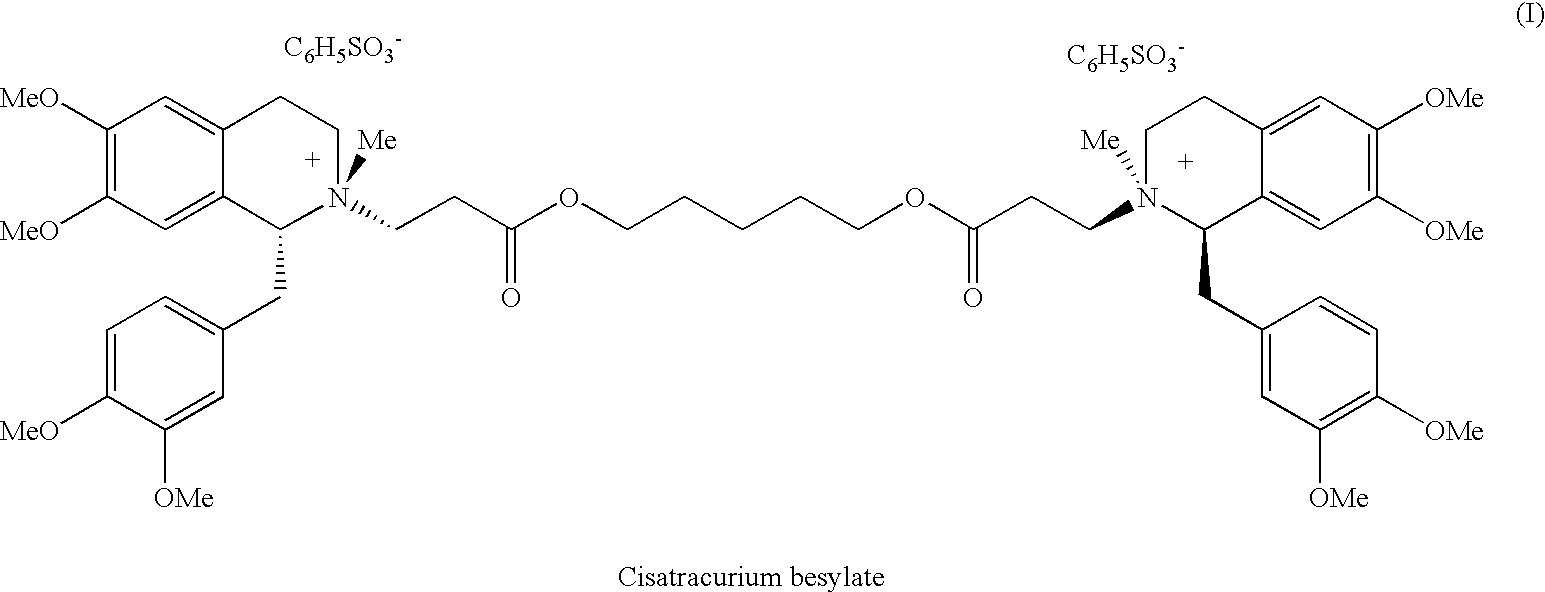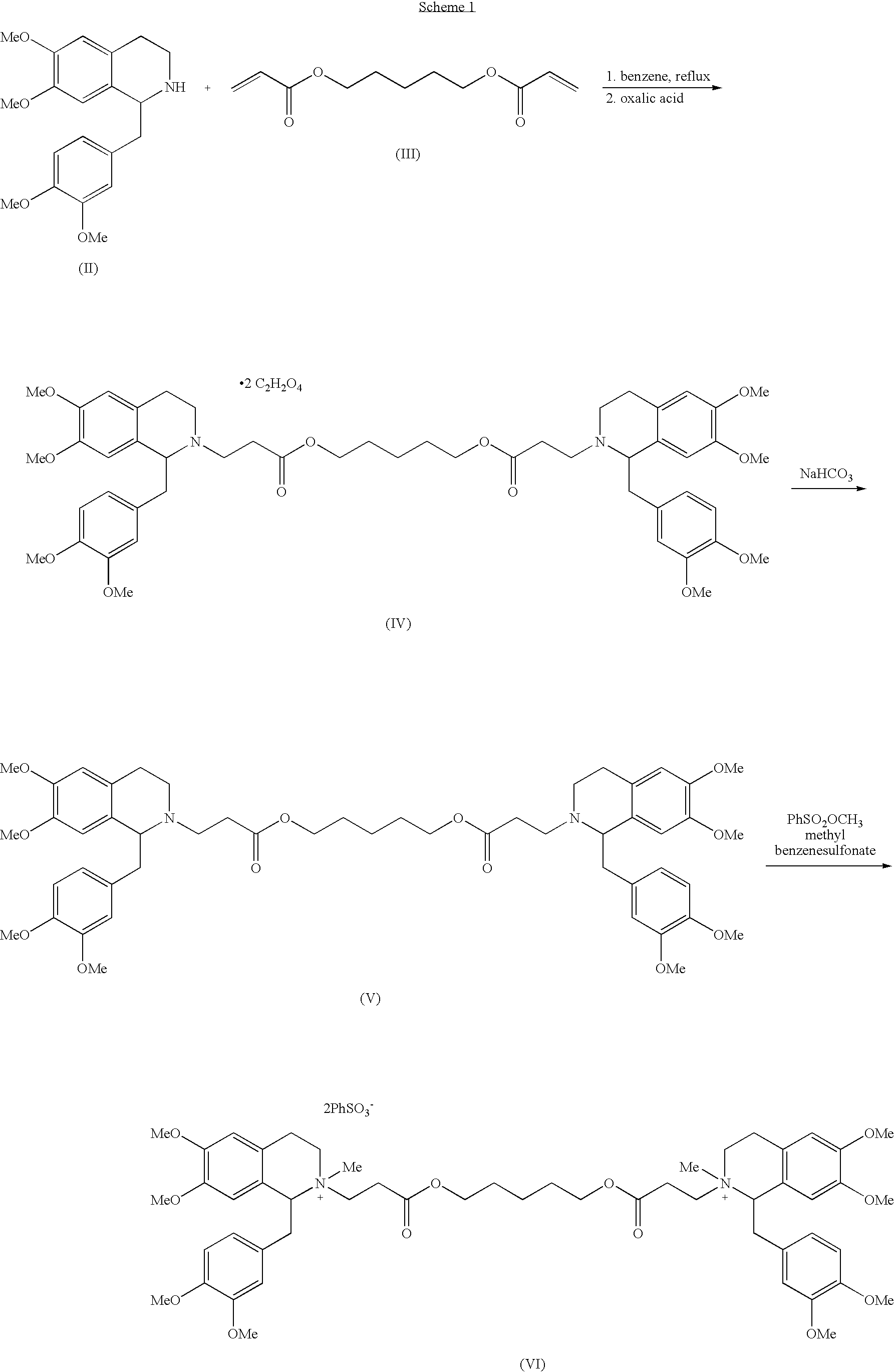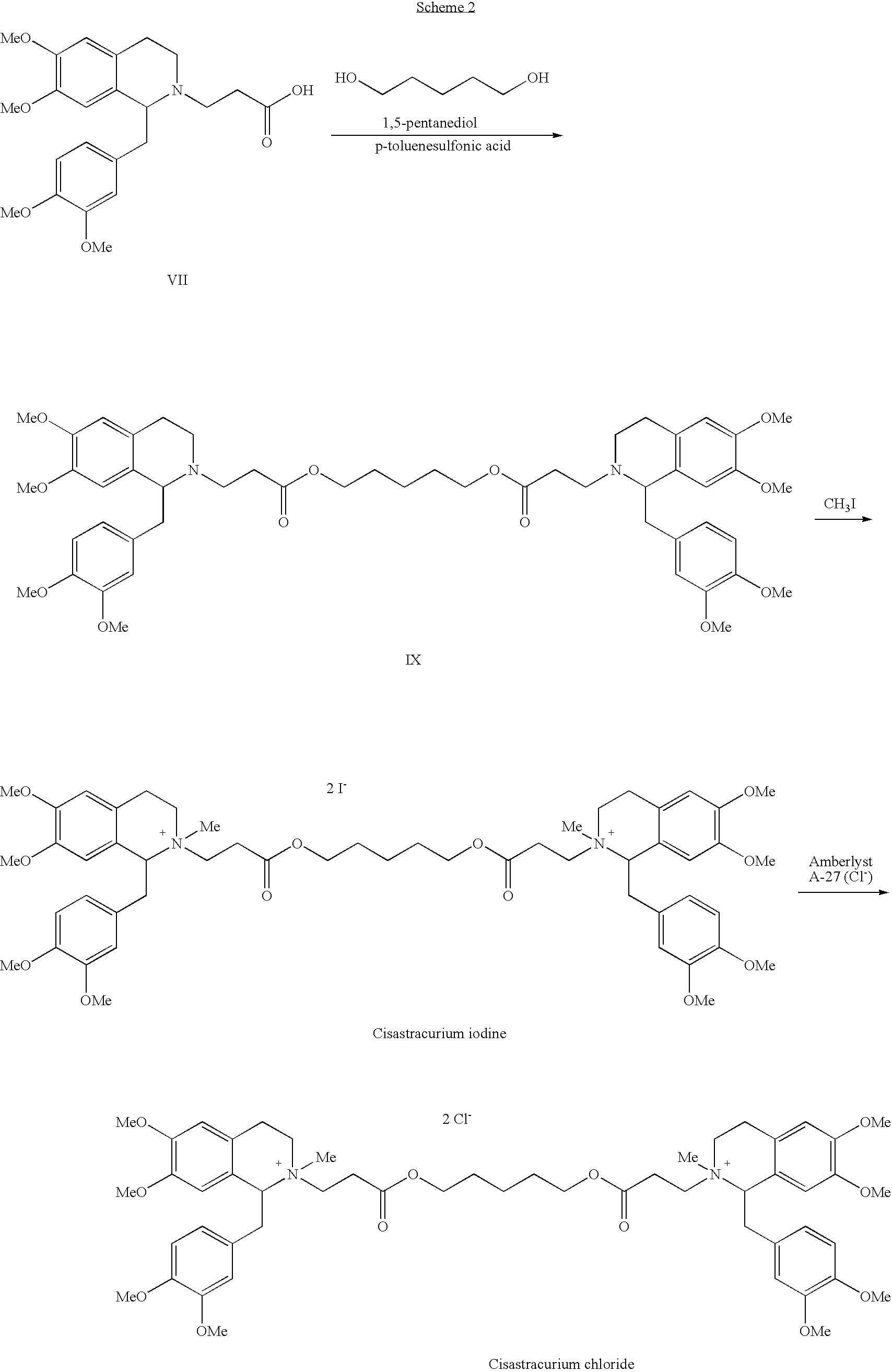Process for producing cisatracurium and associated intermediates
a technology of cisatracurium and intermediates, applied in the field of organic chemistry, can solve the problems of large waste solvent quantities, large quantity of waste solvents, and undesirable hplc purification in a large-scale operation
- Summary
- Abstract
- Description
- Claims
- Application Information
AI Technical Summary
Problems solved by technology
Method used
Image
Examples
example 1
[0056]This example describes the preparation of cisatracurium besylate.
[0057]A mixture of (1R-cis)-1-[(3,4-dimethoxyphenyl)methyl]-1,2,3,4-tetrahydro-6,7-dimethoxy-2-methyl-2-carboxyethyl-isoquinolinium besylate (Compound VIIA wherein R is H) (hereinafter the “cis-acid besylate”) (1.18 g, 2 mmol), anhydrous 1,5-pentanediol (0.1 g, 0.96 mmol, 0.48 eq.), benzenesulfonic acid (0.175 g, 1.11 mmol, 0.56 eq.) and anhydrous CaSO4 (2.0 g) in dichloromethane (20 ml) was stirred at ambient temperature for 23 hours to afford a reaction mixture containing 75.1% of cisatracurium besylate, 8.7% of (1R-cis)-1-[(3,4-dimethoxyphenyl)methyl]-1,2,3,4-tetrahydro-6,7-dimethoxy-2-methyl-2-[3-[(5-hydroxypentyl)oxy]-3-oxopropyl-isoquinolinium besylate, the monoester besylate (Compound VIII), and 16.2% of the cis-acid besylate starting material. Then, benzenesulfonic acid (0.05 g) and CaSO4 (0.8 g) were added to the reaction mixture and the mixture was stirred at ambient temperature for additional 24 hours....
example 2
[0058]This example describes the preparation of cisatracurium besylate.
[0059]A mixture of the cis-acid besylate (1.0 g, 1.7 mmol), anhydrous 1,5-pentanediol (0.085 g, 0.82 mmol, 0.48 eq.), benzenesulfonic acid (0.3 g, 1.89 mmol, 1.1 eq.) and anhydrous CaSO4 (2.0 g) in dichloromethane (20 ml) was stirred at ambient temperature for 23 hours to afford a reaction mixture containing 90.5% of cisatracurium besylate, 4.3% of monoester besylate (compound VIII) and 5.2% of cis-acid besylate. CaSO4 was then collected by filtration and the filtrate was washed with water (3×30 ml). The phases were separated and the organic phase was dried over MgSO4 and the dichloromethane was evaporated under reduced pressure to obtain a crude product as colorless foam. n-pentane (20 ml) was added to the foam and the mixture was stirred at ambient temperature for 2 hours to obtain a suspension. The solvent was evaporated under reduced pressure to afford crude cisatracurium as colorless solid. Yield: 0.95 g, 93...
example 3
[0060]This example describes the preparation of cisatracurium besylate.
[0061]A mixture of cis-acid besylate (5.0 g, 8.5 mmol), anhydrous 1,5-pentanediol (0.43 g, 4.13 mmol, 0.486 eq.), benzenesulfonic acid (1.5 g, 9.48 mmol, 1.1 eq.) and anhydrous CaSO4 (12.5 g) in dichloromethane (100 ml) was stirred at ambient temperature for 24 hours to afford a reaction mixture containing 90.5% of cisatracurium besylate, 3.0% of monoester besylate and 6.5% of cis-acid besylate. CaSO4 was then collected by filtration and the filtrate was washed with water (6×70 ml). The organic phase was dried over MgSO4 and the dichloromethane was evaporated under reduced pressure to obtain a crude product as colorless foam. Toluene (50 ml) was added to the foam and the mixture was stirred at ambient temperature for half an hour and then the toluene was removed to dryness under reduced pressure to obtain a solid. n-pentane (50 ml) was added to the solid, the mixture was stirred at ambient temperature for 2 hours...
PUM
| Property | Measurement | Unit |
|---|---|---|
| temperature | aaaaa | aaaaa |
| pH | aaaaa | aaaaa |
| temperature | aaaaa | aaaaa |
Abstract
Description
Claims
Application Information
 Login to View More
Login to View More - R&D
- Intellectual Property
- Life Sciences
- Materials
- Tech Scout
- Unparalleled Data Quality
- Higher Quality Content
- 60% Fewer Hallucinations
Browse by: Latest US Patents, China's latest patents, Technical Efficacy Thesaurus, Application Domain, Technology Topic, Popular Technical Reports.
© 2025 PatSnap. All rights reserved.Legal|Privacy policy|Modern Slavery Act Transparency Statement|Sitemap|About US| Contact US: help@patsnap.com



